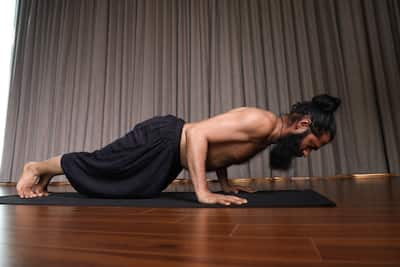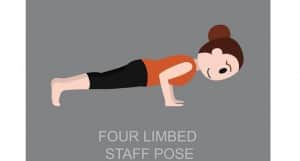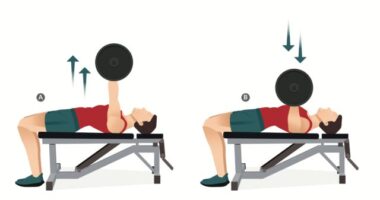
Chaturanga Dandasana: How To Practice Four-Limbed Staff Pose?
“Chaturanga” is the abbreviation for the yoga pose’s full name, chaturanga dandasana. It is frequently called a low plank, but no Sanskrit word exists. If we comprehend the Sanskrit term, we may understand the quality and shape generated by this attitude. Asana is posture or stance; Danda is a pole or staff; Chatur is four; and Anga is a limb. You must contract the muscles from the front to the rear of your body to perform Chaturanga correctly. Keep your elbows close to your ribs rather than let them splay outward. Your chest can remain up in a hover because of this.
Chaturanga Dandasana
Additionally, it would be best to strengthen your arms and legs and engage your abs and shoulders to stay stable in the pose. Even seasoned practitioners struggle with Chaturanga Dandasana. Utilising your arm power is crucial to maintaining this position. To get the best right angle at both elbows, contract your biceps and triceps. Step-by-step formation of Chaturanga Dandasana by Founder of Akshar Yoga Institutions, Himalayan Siddhaa Akshar Spiritual and Yoga Leader.
READ RELATED: 5 Measures To Boost Mental Health In The Workplace
- As you rise to your toes from Plank Pose, place your shoulders slightly in front of your wrists.
- Create a straight, tight line of energy from the top of your head through your feet by pushing back through your heels to contract your quadriceps as you reach your sternum forward.
- Release your tailbone towards the floor while pulling your lower body up and in.
- On an out-breath, steadily lower your body till your elbows are at about a 90-degree angle and flex your elbows while holding a plank-like pose. Keep your elbows tucked up towards your sides, right above your wrists.
- Lower yourself until your shoulders are the same height as your elbows, then bring your attention to the floor approximately 6 inches before you.
- As you breathe, keep reaching through your heels, sternum, and crown of your head.
- Exhale and either push back to the Plank posture or lower your belly to exit the pose.

Benefits Of Chaturanga Dandasana
- Prepares the body by enhancing wrist and arm strength and abdominal, core, and lower back muscular tone.
- It improves posture by strengthening the muscles that surround the spine, comparable to a typical push-up.
- Permits wrists and elbows to flex for more challenging arm balances.
Contraindications
- Do not perform chaturanga if you have carpal tunnel syndrome, shoulder, elbow, or wrist pain.
- Pregnant ladies should not do the whole posture.
Total Wellness is now just a click away.
Follow us on
window.addEventListener(‘load’, (event) => {
// $(document).ready(function(){
$(‘#commentbtn’).on(“click”,function(){
(function(d, s, id) { var js, fjs = d.getElementsByTagName(s)[0]; if (d.getElementById(id)) return; js = d.createElement(s); js.id = id; js.src = “//connect.facebook.net/en_US/sdk.js#xfbml=1&version=v2.3”; fjs.parentNode.insertBefore(js, fjs);}(document, ‘script’, ‘facebook-jssdk’));
$(“.cmntbox”).toggle();
});
// });
});







